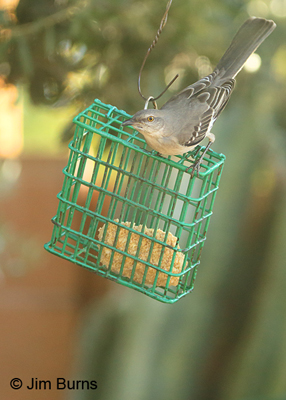
The breeding season for Northern Mockingbird, a species widespread and common throughout the southern half of the country and ranging northward into Canada on the Atlantic coast, runs from mid-February through mid-September depending on latitude. It is common and often comical during breeding season to see mockingbirds chasing one another in territorial disputes, often for several minutes without respite or resolve, round and round in circles through entire neighborhoods. Frequently this involves two mated pairs, males chasing males, their females chasing one another. It is also common to see males of a nesting pair attacking cats, squirrels, and snakes that venture into the vicinity of incubating or brooding females on the nest.
One weekend morning last November, well outside mocker breeding season, after we had filled our backyard suet and seed feeders we heard strange noises—the rush of wings, alarm calls, clunking sounds, quail chip notes. Carefully approaching the patio door, we saw our mockingbird, frenetic and on the wing, chasing doves, House Finches, and Lesser Goldfinches from the seed, then strafing the quail that were picking at fallen olives, then flying at any thrasher or woodpecker who dared land on the suet.
The smaller birds were scattering everywhere with every mocker sortie, the quail were flinching and ducking, and the birds on the suet simply left the yard to escape the constant harassment. This continued all morning and into the afternoon until we decided we had things we had to get done that day and stopped watching. Eventually the only birds remaining in the yard were the quail, the only species large enough not to be totally bullied. They finally began to ignore the maniacal behavior unless the mockingbird made bodily contact, which did happen on several occasions.
Though the mockingbird frequently perched pugnaciously atop the suet, it spent little time actually feeding. We finally decided this must be territorial defense attributable to an unseasonal infusion of breeding hormones. This behavior lasted for days until we finally left for two weeks over Christmas, filling all the feeders before we went. Fully expecting empty feeders to greet our return, imagine our surprise to find everything untouched!
Within a week of our return, normal bird activity seemed to resume. We are filling our feeders now every couple days, typical for this time of year. The sparrows and finches come early, the quail vacuum up the fallen seed, a pair of lovebirds show up every now and then, woodpeckers and thrashers squabble with the starlings over the suet. We see the mockingbird, at least daily, ignoring the other birds, calmly picking at olives or having a turn at the suet, acting very normal. He should soon be thinking territorially. We are curious to see what happens, but we are even more curious about what did happen, especially while we were out of town, as we can only assume his bizarre behavior continued through the duration of our trip.